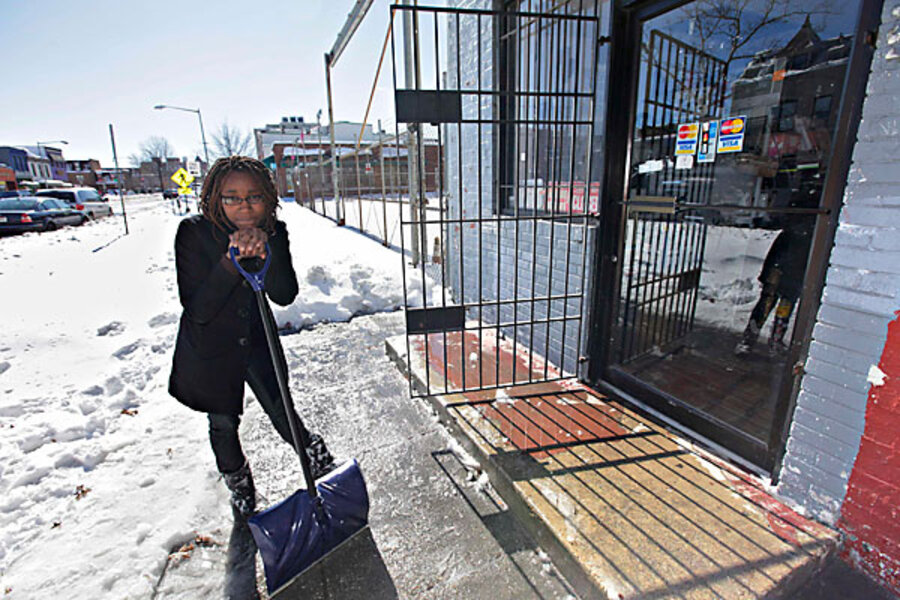How much does that snow storm cost, anyway?
Loading...
| New York
Snow melts.
But will this month's blizzards, which have helped break snowfall records across the mid-Atlantic, cause the economy to melt as well?
The short answer is: for only as long as it takes for a snowball to turn to water.
Economists consider winter weather events, such as those that hit the mid-Atlantic and the Northeast, transitory events. Eventually, the plows clear the roads and consumers head for their favorite restaurants and shops.
“In terms of the impact on the nation’s gross domestic product, it’s usually pretty small,” says David Wyss, chief economist at Standard & Poor’s in New York. “You may lose some days at work, but you can make up for it in the weeks ahead.”
But there is also no doubt there is a cost to the economy, and it is likely to be measured in the billions. “We will get up in the billions in a snap,” says Scott Bernhardt, chief operating officer at Planalytics, a Wayne, Pa., firm that forecasts weather for businesses, rolling off some of the larger effects of the storms: $100 million a day in lost government productivity, millions of dollars in municipal plowing and overtime expenses, as well as lost sales.
Of course, in a $14.5 trillion economy, a few billion dollars won’t make that much difference. “We will probably see it in some monthly numbers, such as retail sales, or even some weekly numbers, like the new claims for unemployment, since you can’t apply when the office is closed,” says Mr. Wyss.
And unlike some weather events, such as hurricanes, the economy won’t get a boost from the recovery process, he points out. After hurricane Katrina, the nation’s GDP rose in the following quarter, as demand soared for such things as wall board and lumber products. “The effect of all that water from a hurricane is longer lasting than snow, and then you also have the rebuilding afterward,” says Wyss.
One of the larger costs that won’t get made up is the municipal expense for plowing the snow. In New York, for example, it costs the city an estimated $1 million per inch. In the latest snow storm the city got 10 inches.
Washington Mayor Adrian Fenty has already asked the federal government to help with the cost of snow removal in his beleagured city.
“Once you get south of New York City, you usually don’t get much snow, so you run out of snow money very quickly,” says Wyss.
That’s certainly the case in Newark, Delaware, which has had three major snow events this winter.
“We used up the snow budget in the first storm in December,” says Newark’s Mayor Vance Funk III. “We usually budget based on the average snowfall for the last three years and the total snow in the last three years equaled what we had in December.”
Newark is taking money from other parts of the budget to pay for the additional salt, overtime, and plowing needed to handle the snowfall from the other two storms. “But we’re not prone to run to the federal government, which has enough of its own problems,” says Mr. Funk.
The heavy snowfall is also taking its toll on the restaurant business. “Winter temperatures that are colder than normal have the most dampening impact,” says Hudson Riehle, a senior vice president for the National Restaurant Association, which has researched the impact of weather conditions on its industry. “We’ve had those, so absolutely there will be an effect.”
Retailers also admit it is unfortunate the storms hit in the buildup to Valentine’s Day. But as soon as the roads clear, shoppers may rush out and buy something, says Bill Martin, co-founder of ShopperTrak, a Chicago-based consumer research firm.
“Our experience from the 2007 Valentine’s Day blizzard in the Northeast shows that shoppers will go out on the 15th to buy gifts for missing the 14th,” writes Mr. Martin in an email.
In addition, shoppers do have the option of buying online, assuming the delivery services can get through the drifts to drop off their purchases. “We think online will help the larger stores but probably not the mom and pop shops who could not open their doors,” says Scott Krugman, a spokesman for the National Retail Federation.
The good news, he adds, is the weather forecast for the Valentine’s Day weekend and President’s Day is favorable for the eastern third of the country.
Follow us on Twitter.





